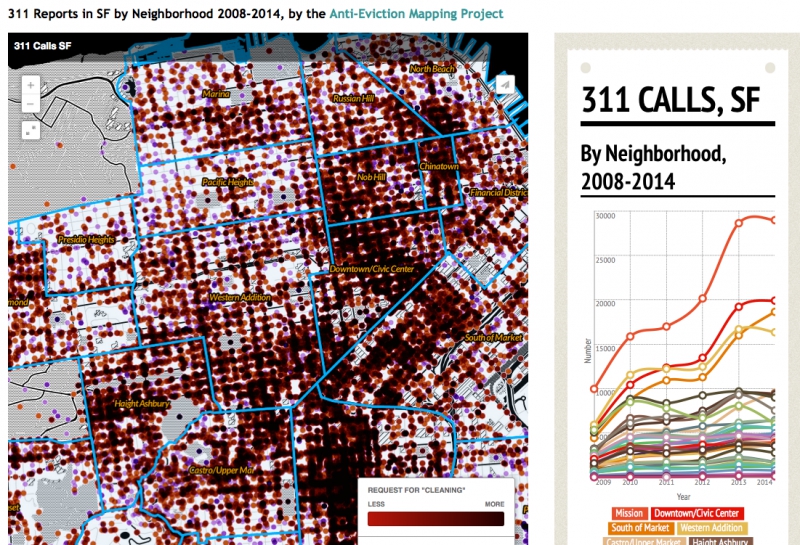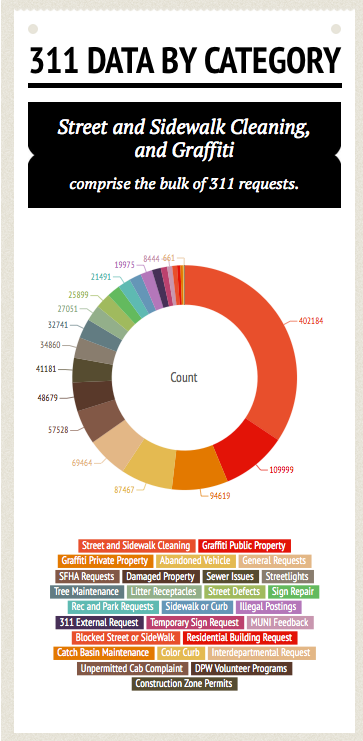From the Open-Publishing Calendar
From the Open-Publishing Newswire
Indybay Feature
311 Reports in SF as Possible Gentrification Indicator
The Anti-Eviction Mapping Project has mapped all 311 requests made to the city from 2008 to 2014: http://www.antievictionmappingproject.net/311.html. In San Francisco, the bulk of 311 requests are related to "cleaning" up buildings, sidewalks, and streets. How much do such requests indicate hyper-gentrification? In SoMa and the mid-Market region, the majority of the requests are proximate to the Twitter tax break zone, where numerous tech companies have settled over the last few years. Chinatown and the Mission have been ground zeros for evictions since 2012, and we have seen increased call volumes within them. Furthermore, we have witnessed new developers such as Maximus contract groups like "Clean Up the Plaza" to rid the 16th Street BART Plaza in the Mission from its homeless population, resulting in increased policing of youth of color.
Are 311 calls an indicator of gentrification?
This question has been asked in other cities as well, such as New York. In "A Call in for Gentrifiers On When You Call 311 vs. When You Adapt to the Conditions of your New Neighborhood," the Brian Lehrer Show posed the inquiry. A caller from Harlem brought up gentrification as a key framework to explain the frequency of quality of life crimes reported to both 311 and 911, explaining that many complaints by new residents are due to gentrifiers "not understanding or accommodating existing cultural norms, such as loud block parties or music."
Are 311 calls an indicator of gentrification?
This question has been asked in other cities as well, such as New York. In "A Call in for Gentrifiers On When You Call 311 vs. When You Adapt to the Conditions of your New Neighborhood," the Brian Lehrer Show posed the inquiry. A caller from Harlem brought up gentrification as a key framework to explain the frequency of quality of life crimes reported to both 311 and 911, explaining that many complaints by new residents are due to gentrifiers "not understanding or accommodating existing cultural norms, such as loud block parties or music."
On 311
311 emerged in the 1980s across the United States when urban leaders began endeavoring to reduce nonemergency 911 calls. When Bloomberg was elected in New York in 2002, he promulgated use of the hotline. Backing it with resources and a highly publicized roll-out, Bloomberg's 311 became a huge success, and was quickly disseminated in other large cities.
There are nearly 300 cities with a 311 system or a similar infrastructure that use customer relations management technology to track service requests (See Newcombe 2014). While only large cities could afford 311 at first, decrease in technology costs resulted in smaller municipalities using the service as well. The economic recession caused some cities such as New Orleans and Detroit to pull the service, but in recent years, the technology is spreading once more. Cities that have already been implementing 311 are now incorporating social media and apps into its infrastructure.
311 was introduced to the Board of Supervisors in San Francisco in 2000. The budget for implementation was approved in 2005, and there was a citywide kickoff in September. Under Mayor Gavin Newsom and then City Administrator Ed Lee, the program was publicly launched in 2007. Online services began in 2008, and it began using Twitter in 2009.
In 2013, Mayor Lee launched the the Open311 platform for mobile apps. As the Office of the Mayor reported, "The new SF311 app for residents and visitors to San Francisco allows users to quickly and easily report quality of life issues by sending pictures, a brief description and a map-based location. Whether reporting issues such as graffiti, potholes, or street cleaning, the City’s new SF311 app simplifies and streamlines the process, ensuring it routes directly to the appropriate servicing agency for quicker response time. The user can view the status of the case in the app and receive a notification of its completion. . . In addition to being able to talk to a live Customer Service Representative by phone 24 hours a day, 7 days a week, every day of the year in over 170 languages, the public can use Twitter, Facebook, the Web, and now the mobile SF311 app. The new SF311 App is available on both Apple iPhone and Android platforms and can be downloaded for free from the Apple iTunes App Store and the Google Play Store, respectively."
On the "Broken Windows" Theory
The "Broken Windows" theory was first advanced in 1982 in an article by social scientists James Wilson and George Kelling, - the idea being that close monitoring and maintenance of urban environments will stop more serious crimes from occurring. The theory goes that if a window is broken and left unrepaired, all the rest of the windows will soon be broken, looting and further damage will occur; untended property is fair game for vandals and criminals. Kelling went on to be hired by the New York Transit Authority to implement his theory, and at that time, in the 1980s, graffiti on subways was targeted as a sort of "broken window" that if fixed would improve the "quality of life" in NYC. Republican mayor Rudy Giuliani appointed William Bratton of the transit police as his police commissioner to implement “quality of life" and "zero tolerance" policies across NYC.
Focusing on petty crimes and graffiti, the New York policies have been debated on many points, including validity, effectiveness, racial and economic bias, and most recently as the motivation for "Stop and Frisk" policing in New York. Nevertheless, the theory has been accepted in many cities, and is held by many to be central to the process of gentrification. Communities of color, youth and working people are often targeted by policies that that promote the inflation of real estate prices, while powerful real estate interests, and certain City government representatives promote any development that increases profits and the tax base.
Incidentally, as written about by the Community Rejuvenation Project, William Bratton was hired as a consultant to Oakland in 2013 at the same meeting that Oakland passed an anti-graffiti ordinance.
Broken Windows policing has been getting much attention in the recent months, after the chokehold murder of Eric Garner in New York by police was captured on video. Garner had been harassed for selling cigarettes, and was one of many residents exhausted by the constant police attention to petty crimes. In Miami, police murdered graffiti mural artist Israel “Reefa” Hernandez after catching him painting in the street.
311 emerged in the 1980s across the United States when urban leaders began endeavoring to reduce nonemergency 911 calls. When Bloomberg was elected in New York in 2002, he promulgated use of the hotline. Backing it with resources and a highly publicized roll-out, Bloomberg's 311 became a huge success, and was quickly disseminated in other large cities.
There are nearly 300 cities with a 311 system or a similar infrastructure that use customer relations management technology to track service requests (See Newcombe 2014). While only large cities could afford 311 at first, decrease in technology costs resulted in smaller municipalities using the service as well. The economic recession caused some cities such as New Orleans and Detroit to pull the service, but in recent years, the technology is spreading once more. Cities that have already been implementing 311 are now incorporating social media and apps into its infrastructure.
311 was introduced to the Board of Supervisors in San Francisco in 2000. The budget for implementation was approved in 2005, and there was a citywide kickoff in September. Under Mayor Gavin Newsom and then City Administrator Ed Lee, the program was publicly launched in 2007. Online services began in 2008, and it began using Twitter in 2009.
In 2013, Mayor Lee launched the the Open311 platform for mobile apps. As the Office of the Mayor reported, "The new SF311 app for residents and visitors to San Francisco allows users to quickly and easily report quality of life issues by sending pictures, a brief description and a map-based location. Whether reporting issues such as graffiti, potholes, or street cleaning, the City’s new SF311 app simplifies and streamlines the process, ensuring it routes directly to the appropriate servicing agency for quicker response time. The user can view the status of the case in the app and receive a notification of its completion. . . In addition to being able to talk to a live Customer Service Representative by phone 24 hours a day, 7 days a week, every day of the year in over 170 languages, the public can use Twitter, Facebook, the Web, and now the mobile SF311 app. The new SF311 App is available on both Apple iPhone and Android platforms and can be downloaded for free from the Apple iTunes App Store and the Google Play Store, respectively."
On the "Broken Windows" Theory
The "Broken Windows" theory was first advanced in 1982 in an article by social scientists James Wilson and George Kelling, - the idea being that close monitoring and maintenance of urban environments will stop more serious crimes from occurring. The theory goes that if a window is broken and left unrepaired, all the rest of the windows will soon be broken, looting and further damage will occur; untended property is fair game for vandals and criminals. Kelling went on to be hired by the New York Transit Authority to implement his theory, and at that time, in the 1980s, graffiti on subways was targeted as a sort of "broken window" that if fixed would improve the "quality of life" in NYC. Republican mayor Rudy Giuliani appointed William Bratton of the transit police as his police commissioner to implement “quality of life" and "zero tolerance" policies across NYC.
Focusing on petty crimes and graffiti, the New York policies have been debated on many points, including validity, effectiveness, racial and economic bias, and most recently as the motivation for "Stop and Frisk" policing in New York. Nevertheless, the theory has been accepted in many cities, and is held by many to be central to the process of gentrification. Communities of color, youth and working people are often targeted by policies that that promote the inflation of real estate prices, while powerful real estate interests, and certain City government representatives promote any development that increases profits and the tax base.
Incidentally, as written about by the Community Rejuvenation Project, William Bratton was hired as a consultant to Oakland in 2013 at the same meeting that Oakland passed an anti-graffiti ordinance.
Broken Windows policing has been getting much attention in the recent months, after the chokehold murder of Eric Garner in New York by police was captured on video. Garner had been harassed for selling cigarettes, and was one of many residents exhausted by the constant police attention to petty crimes. In Miami, police murdered graffiti mural artist Israel “Reefa” Hernandez after catching him painting in the street.
For more information:
http://www.antievictionmappingproject.net/...
Add Your Comments
We are 100% volunteer and depend on your participation to sustain our efforts!
Get Involved
If you'd like to help with maintaining or developing the website, contact us.
Publish
Publish your stories and upcoming events on Indybay.
Topics
More
Search Indybay's Archives
Advanced Search
►
▼
IMC Network




